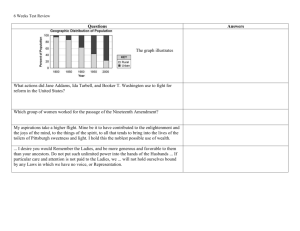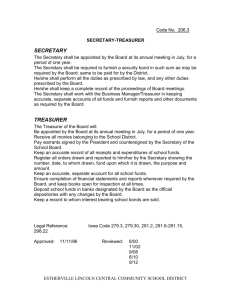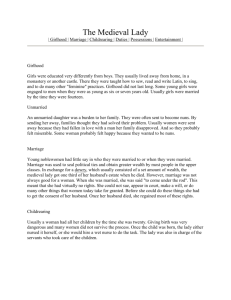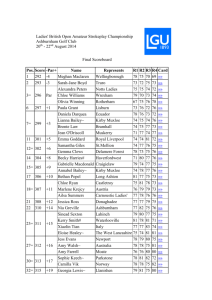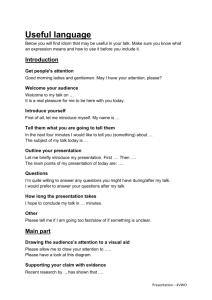Permuatations and combinations
advertisement
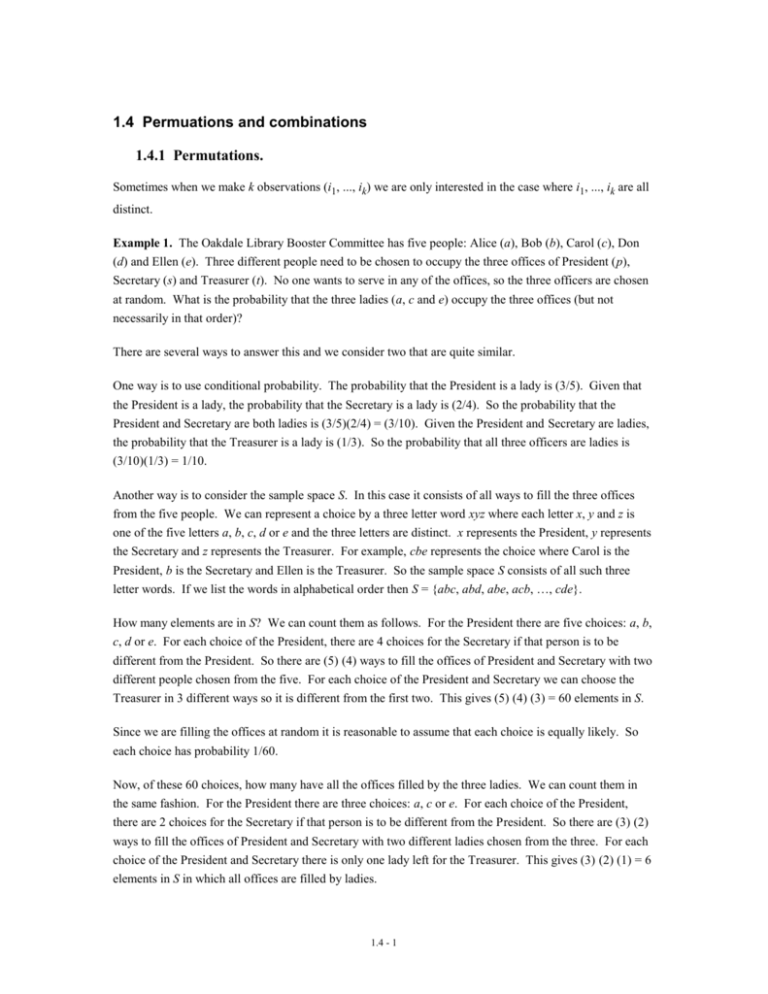
1.4 Permuations and combinations
1.4.1 Permutations.
Sometimes when we make k observations (i1, ..., ik) we are only interested in the case where i1, ..., ik are all
distinct.
Example 1. The Oakdale Library Booster Committee has five people: Alice (a), Bob (b), Carol (c), Don
(d) and Ellen (e). Three different people need to be chosen to occupy the three offices of President (p),
Secretary (s) and Treasurer (t). No one wants to serve in any of the offices, so the three officers are chosen
at random. What is the probability that the three ladies (a, c and e) occupy the three offices (but not
necessarily in that order)?
There are several ways to answer this and we consider two that are quite similar.
One way is to use conditional probability. The probability that the President is a lady is (3/5). Given that
the President is a lady, the probability that the Secretary is a lady is (2/4). So the probability that the
President and Secretary are both ladies is (3/5)(2/4) = (3/10). Given the President and Secretary are ladies,
the probability that the Treasurer is a lady is (1/3). So the probability that all three officers are ladies is
(3/10)(1/3) = 1/10.
Another way is to consider the sample space S. In this case it consists of all ways to fill the three offices
from the five people. We can represent a choice by a three letter word xyz where each letter x, y and z is
one of the five letters a, b, c, d or e and the three letters are distinct. x represents the President, y represents
the Secretary and z represents the Treasurer. For example, cbe represents the choice where Carol is the
President, b is the Secretary and Ellen is the Treasurer. So the sample space S consists of all such three
letter words. If we list the words in alphabetical order then S = {abc, abd, abe, acb, …, cde}.
How many elements are in S? We can count them as follows. For the President there are five choices: a, b,
c, d or e. For each choice of the President, there are 4 choices for the Secretary if that person is to be
different from the President. So there are (5) (4) ways to fill the offices of President and Secretary with two
different people chosen from the five. For each choice of the President and Secretary we can choose the
Treasurer in 3 different ways so it is different from the first two. This gives (5) (4) (3) = 60 elements in S.
Since we are filling the offices at random it is reasonable to assume that each choice is equally likely. So
each choice has probability 1/60.
Now, of these 60 choices, how many have all the offices filled by the three ladies. We can count them in
the same fashion. For the President there are three choices: a, c or e. For each choice of the President,
there are 2 choices for the Secretary if that person is to be different from the President. So there are (3) (2)
ways to fill the offices of President and Secretary with two different ladies chosen from the three. For each
choice of the President and Secretary there is only one lady left for the Treasurer. This gives (3) (2) (1) = 6
elements in S in which all offices are filled by ladies.
1.4 - 1
So the probability that all three offices are filled by ladies is 6/60 = 1/10.
This example illustrates the following counting formula. Suppose we have n objects x1, ..., xn and we
choose k of them in order. We can represent such a choice by a vector (i1, ..., ik) using k of these where
k n. We are interested in the number of such vectors where i1, ...ik are all distinct. Arguing as above, we
see that the number of such vectors is n (n-1)...(n-k+1). This number can be written as n!/(n-k)! and is
called the number of permutations of n things taken k at a time. Sometimes it is denoted by Pn,k or P(n,k).
Thus
(1)
Pn,k = P(n,k)
=
n!
(n-k)!
= number of ways of selecting k different items in order from n objects
= number of permutations of n things taken k at a time
An important special case is where k = n. A vector (i1, ..., in) which uses all of x1, ..., xn exactly once is just
a rearrangement of x1, ..., xn and is often called a permuatation of x1, ..., xn. The number of different
permuatations of x1, ..., xn is n!.
Example 2. How many 3 letter words can we make where all 3 letters are distinct?
Solution. There are 26 possible choices for the first letter. For each choice of the first letter, there are 25
choices for the second letter if it is to be different from the first. So there are (26) (25) two letter words
where the 2 letters are different. For each of these we can choose a third letter in 24 different ways so it is
different from the first two. This gives (26) (25) (24) = 15,600 three letter words which have all 3 letters
distinct.
Example 3. Suppose a room has 17 people. What is the probability that the people have birthdays which
are all distinct?
We shall simplify the problem by assuming that none of them have birthdays which fall on February 29. If
we number the people in some fashion from 1 to 17, then the birthdays of the 17 people can be represented
by a vector (b1, ..., b17), where each bi is the birthday of the i-th person and can have any of 365 values. So
there are 36517 possible outcomes and we assume they are all equally likely. The birthdays being all
distinct corresponds to b1, ..., b17 being all distinct. By the paragraph above, the number of vectors
(b1, ..., b17) with this property is (365) (364) ... (349). So the probability that they are all distinct is
(365) (364) ... (349)
= 0.685.
36517
Problem 1. A license plate has 3 letters followed by 3 digits. What is the probability that two or more
of the letters or digits are the same?
1.4 - 2
1.4.2 Combinations.
Here we are interested in the number of ways we can select k different objects from a set of n objects
without regard to order. Here is an example that illustrates this.
Example 4. As in Example 1, The Oakdale Library Booster Committee has five people: Alice (a), Bob (b),
Carol (c), Don (d) and Ellen (e). A committee of three people needs to be chosen to do the work involved
in hosting the club's annual Christmas party. Again, no one wants to be on the committee, so the three
people are chosen at random. What is the probability that the three ladies (a, c and e) are the ones chosen?
We can answer this in ways similar to Example 1.
One way is to assume we choose the three committee members in order, even though the order in which
they are chosen is ignored once they are on the committee. The probability that the first chosen is a lady is
(3/5). Given that the first chosen is a lady, the probability that the second chosen is a lady is (2/4). So the
probability that the first two chosen are both ladies is (3/5)(2/4) = (3/10). Given the first two chosen are
both ladies, the probability that the third chosen is also lady is (1/3). So the probability that all three chosen
are ladies is (3/10)(1/3) = 1/10.
Another way is to consider the sample space T which is related to, but slightly different from, the sample
space S in Example 1. In this case T consists of all three element subsets of the set of five people. For
example, {b, c, e} represents the committee with Bob, Carol and Ellen is the Treasurer. Of course, this is
the same as {e, b, c} and {c, e, b}. One way to avoid duplicating a committee is to insist that the letters be
in alphabetical order when we list them in the set. Thus, we would use {b, c, e} but not {e, b, c} and {c, e,
b}. Also, to make writing a subset easier, we could simply write it as a three letter word. For example, we
could represent {b, c, e} by bce.
With this in mind,
T = {abc, abd, abe, acb, ace, ade, bcd, bce, bde, cde}
So there are ten elements in T. Since we choosing the committee at random it is reasonable to assume that
each choice is equally likely. So each choice has probability 1/10. Only one of these, ace, consists of all
ladies. So the probability that the committee consists of all ladies is 1/10.
There is a connection between the 60 element sample space S in Example 1 and the 10 element sample
space T for this problem. Each three letter word corresponds to a three element subset. For example, the
three letter word ebc corresponds to the subset {e, b, d}. However, different three letter words correspond
to the same subset. For example bde, bed, dbe, deb, ebd and edb all correspond to the subset {e, b, d}. In
fact for each subset in T there are 3! = 6 ways to rearrange the three letters to form a 3 letter word in S. So
# different 3 letter words with all letters different =
(# ways to choose 3 letters) (# permutations of 3 letters)
1.4 - 3
i.e.
60 = (10) (6).
More generally, suppose we want to count the number of different ways of selecting a set of k different
objects {i1, ..., ik} from a set of n items {x1, ..., xn}. This quantity is called the number of combinations of n
(n )
things taken k at a time and denoted by k or C(n,k). It is also called the binomial coefficient of n things
taken k at a time. This is related to the number of different ways of selecting a vector (i1, ..., ik) where
i1, ..., ik are different elements of {x1, ..., xn}. Arguing as above, we have
# different vectors = (# ways to choose k objects) (# permutations of k objects)
n!
= (# ways to choose k objects) = k!
(n-k)!
i.e.
So,
(nk )
(2)
=
n!
k! (n-k)!
= number of ways of selecting k objects from n
= number of combinations of n things taken k at a time
Example 5. The Michigan State Lottery has a game called Super Lotto where six different balls are drawn
at random from a set of 47 balls numbered 1, 2, ..., 47. By (2), there are
47 = 47! = 47*46*45*44*43*42 = 10,737,573
6
6! 41!
6*5*4*3*2
ways to do this. Prior to the drawing, people may select their own set of six different numbers from the
numbers 1, 2, ..., 47. If their set of six numbers matches the ones drawn by the state, they win a big prize.
If we assume that each group of six different numbers is equally likely, then the probability of winning is
1/10,737,573.
1.4 - 4
